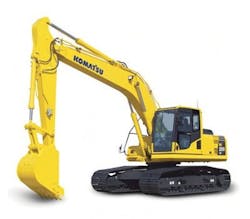Komatsu PC200LC-8 Hybrid Excavator 'Swings' into Action
Hybrid technology is all the rage these days. Carmakers continue to add hybrid vehicles to their product line-ups, and in the last few years, construction-equipment manufacturers also have entered the game. Volvo, for instance, will soon bring a hybrid wheel loader to the market, and Doosan and Kobelco both are developing a hybrid excavator.
In North America, the first equipment manufacturer to get out of the gate with a large hybrid excavator is Komatsu, which has begun putting its Hybrid PC200LC-8 into the hands of U.S. suppliers. Komatsu began selling the hybrid excavator to Japanese construction companies in mid-2008 and to Chinese companies in August 2009.
Taking a cue from hybrid cars, which produce energy from the friction of braking, the Hybrid PC200LC-8 generates electricity each time the operator brings the upper structure to a stop. AC energy created by the stopping force of the swing motor is sent through an inverter to convert it to DC energy, and then stored in a capacitor.
Unlike hybrid cars that use a battery to store and discharge electricity gradually, Komatsu’s hybrid excavator employs a capacitor instead because of the quick bursts of energy required by large equipment such as excavators. When the capacitor receives DC energy from the inverter, it discharges the energy immediately assist the upper structure or the engine.
“With a capacitor, we can store energy and have instantaneous energy available,” says Komatsu project manager Sean Maloon, “where as a battery would have to wait for a chemical reaction for it to work.”
Also powering the excavator is a generator motor located in between the engine and the hydraulic pump. The generator charges the capacitor when the swing arm is not in use, and it receives energy from the capacitor to help drive the engine.
In terms of performance, the 138-horsepower Hybrid PC200LC-8 is virtually indistinguishable from its non-hybrid brother, Maloon says. Both the hybrid and conventional versions of the PC200LC-8 have an operating weight range of 43,643 and 47,260 pounds. Both excavators also have a digging arm force of 27,780 pounds, swing torque of 49,907 foot-pounds, and digging depth of 21 feet 9 inches. Boom, stick and bucket cycle times remain unchanged.
The differences come into play when measuring fuel use and emissions. According to Komatsu, the Hybrid PC200LC-8 consumes 25 to 41 percent less fuel than its non-hybrid counterpart. It also produces less carbon-dioxide emissions; in a typical hour of operation, the hybrid excavator emits 22 pounds less C02.
The hybrid system is not solely responsible for the reduction in fuel consumption. While the conventional PC200LC-8 runs on a 6-cylinder engine, the hybrid is powered by a 4-cylinder engine. As a result, the hybrid excavator runs at lower idle.
“We lower the cylinder output and the engine RPM, and we use the generator motor and the stored energy in the capacitor to assist this 4-cylinder engine to act like a 6-cylinder engine,” Maloon says. “Less cylinders mean we burn less fuel.”
Because the excavator produces energy via the swing motor, operators will see more fuel savings the more they use the swing function, Maloon says.
“Fuel consumption is far less than a standard machine when you are loading a truck or digging a ditch -- doing a lot of swinging applications,” Maloon says. “If you are not doing a lot of swing applications, then you’re not going to be save as much fuel.”
The cab hosts just a couple of minor changes. The LCD monitor, for example, now displays a readout and status of the hybrid system. Also, just below the monitor sits a red button, which, if engaged, shuts off swing-arm operation in the event that the hybrid system malfunctions.
Komatsu says it is currently able to produce 100 Hybrid PC200LC-8 excavators each month at its Japan facilities. For now, Komatsu is distributing 10 units of the hybrid excavator to construction companies in U.S. regions that have strict emissions requirements.
